As I embarked on my own home furnishing journey, I found myself navigating the seemingly endless choices offered by the giants of the furniture world: West Elm, Pottery Barn, and Crate & Barrel.
Each brand presented a curated vision of home, yet their subtle and not-so-subtle differences left me with countless questions. Which one truly aligned with my personal style? Where would I find the best quality for my budget?
This article is the culmination of my deep dive into these three iconic retailers. My goal is to share my firsthand insights and in-depth analysis to help you confidently decide which brand is the perfect fit for your home and lifestyle.
The Big Three: A Head-to-Head Glance
| Feature | West Elm | Pottery Barn | Crate & Barrel |
| Dominant Style | Mid-Century Modern, Boho, Contemporary | Classic, Traditional, Farmhouse | Modern, Transitional, Timeless |
| Target Audience | Millennials, apartment dwellers, trend-followers | Families, homeowners, lovers of classic design | Design-conscious adults, entertainers, new homeowners |
| Vibe | “Your cool, artsy friend’s impeccably styled loft.” | “A cozy, inviting family home that feels like a warm hug.” | “The sophisticated, well-put-together home of a seasoned host.” |
| Known For | Stylish sofas, unique decor, Fair Trade Certified™ products | Comfortable sectionals, timeless dining sets, holiday decor | Quality kitchenware, sleek furniture, extensive wedding registry |
| Customization | Extensive fabric and finish options for furniture. | Wide range of upholstery choices and personalization. | Ample customization for upholstery and furniture pieces. |
| Sustainability | Strong focus on organic, handcrafted, and sustainably sourced materials. | Increasing commitment to responsibly sourced wood and sustainable cotton. | Focus on durable materials and timeless designs meant to last. |
Diving Deeper: My Personal Take On Each Brand
Choosing furniture is more than just filling a space; it’s about creating a home that reflects who you are. West Elm, Pottery Barn, and Crate & Barrel all offer compelling visions of modern living, but their approaches are distinctly different.
I’ve spent countless hours Browse their showrooms, scrutinizing their online catalogs, and living with their products. Here’s my honest breakdown of what each brand brings to the table.
West Elm: The Trendsetter’s Haven
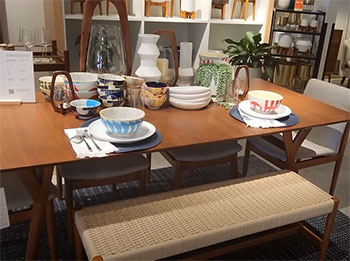
From the moment I walk into a West Elm, I feel a creative energy.
It’s a space that feels curated yet accessible, a blend of mid-century modern-inspired designs with a healthy dose of bohemian flair.
This is the brand that, in my opinion, has its finger most firmly on the pulse of current design trends.
If you’re looking to create a home that feels very “now,” West Elm is likely your first stop.
The West Elm Aesthetic: A Closer Look
West Elm’s design language is heavily influenced by the clean lines and organic shapes of mid-century modernism. Think tapered legs on sofas and sideboards, geometric patterns on rugs and pillows, and a color palette that often leans into earthy tones punctuated by bold, on-trend hues.
But it’s not a stuffy, museum-like interpretation of the past. West Elm infuses this aesthetic with a contemporary, often eclectic, spirit. You’ll find plush velvet upholstery, shiny brass accents, and handcrafted pieces that add a touch of global-inspired artistry.
I’ve always been drawn to their ability to create pieces that feel both stylish and livable. Their sofas, like the popular Harmony and Andes collections, are known for their deep, comfortable seats and customizable configurations.
I’ve spent many an afternoon lounging on a friend’s Harmony sectional, and I can attest to its “sink-in” comfort. It’s the kind of sofa that invites you to curl up with a good book and a cup of tea.
Pros of Shopping At West Elm
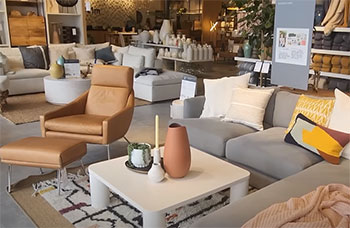
For me, the biggest pro of West Elm is its commitment to unique design and a more youthful, contemporary aesthetic.
They collaborate with independent artists and designers, which results in a collection of decor and furniture that you won’t find everywhere else.
I love their selection of wall art, vases, and decorative objects; they’re perfect for adding personality to a room without breaking the bank.
Another major selling point for me is their focus on sustainability and ethical production. West Elm was the first home retailer to offer Fair Trade Certified™ products, and they have a significant selection of organic cotton bedding, sustainably sourced wood furniture, and handcrafted items.
As a conscious consumer, knowing that my purchase supports artisans and responsible manufacturing practices adds a layer of satisfaction.
Their small-space solutions are also a standout feature. As someone who has lived in apartments for a good portion of my adult life, I appreciate their range of furniture designed for more compact living. From sleek, small-scale sofas to clever storage solutions, West Elm understands the challenges of urban living.
Cons To Consider with West Elm
Now, for the other side of the coin. While I admire West Elm’s trend-forward approach, it can also be a double-edged sword. Some of their more “of the moment” pieces might not have the timeless appeal of a classic Pottery Barn or Crate & Barrel item.
I’ve seen certain trends come and go from their collections quite quickly, which makes me question the longevity of some designs.
Quality can also be a bit of a mixed bag, in my experience. While many of their larger furniture pieces are well-made and durable, I have encountered some smaller decor items and textiles that felt a bit less substantial than their price tags would suggest.
I’ve learned to be a discerning shopper at West Elm, carefully reading reviews and, when possible, seeing items in person before making a significant purchase.
Customer service experiences can also vary. I’ve had wonderful, helpful interactions with their in-store design consultants, but I’ve also read my fair share of online complaints about delivery delays and issues with resolving problems. It’s something to be aware of, especially when ordering larger items.
Pottery Barn: The Epitome of Timeless Comfort
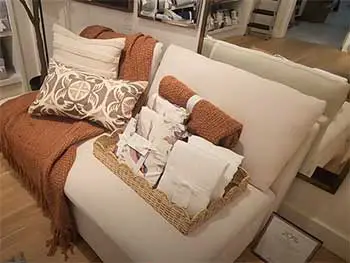
Walking into a Pottery Barn store feels like coming home. There’s a warmth and an inviting quality to their spaces that instantly puts me at ease.
This is the brand I turn to when I’m looking for furniture and decor that feels classic, comfortable, and built to last.
Pottery Barn doesn’t chase fleeting trends; instead, it focuses on creating a sense of enduring style that will look just as good in ten years as it does today.
The Pottery Barn Look and Feel
The Pottery Barn aesthetic is rooted in traditional American design, with strong influences from farmhouse, coastal, and rustic styles.
You’ll find a lot of solid wood furniture with substantial silhouettes, plush, overstuffed sofas and armchairs, and a color palette that favors warm neutrals, soft blues, and classic whites. It’s a look that is both elegant and approachable, sophisticated yet relaxed.
I’ve always been impressed by the sheer comfort of their upholstered furniture. The Pearce and Big Sur collections, for example, are legendary for their deep seats and down-filled cushions.
I once house-sat for a family with a Pearce sectional, and I can honestly say it was one of the most comfortable sofas I’ve ever had the pleasure of sinking into. It’s the kind of furniture that’s made for family movie nights and lazy Sunday afternoons.
Pottery Barn also excels at creating a cohesive look. Their collections are designed to coordinate seamlessly, making it easy to furnish an entire room with a consistent and polished aesthetic.
From bedding and window treatments to dinnerware and lighting, they offer a one-stop-shop for creating a classic, well-put-together home.
The Advantages of Choosing Pottery Barn
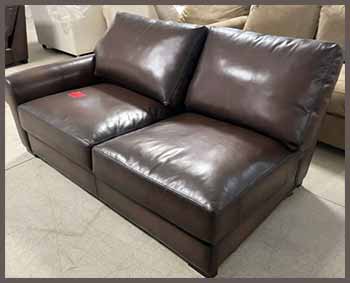
For me, the primary advantage of Pottery Barn is the quality and durability of their products.
Their furniture, particularly their solid wood pieces, is built to withstand the rigors of family life.
I have a Pottery Barn coffee table that has survived years of propped-up feet, spilled drinks, and a few accidental bumps and scrapes, and it still looks fantastic.
There’s a reassuring heft and solidity to their furniture that speaks to its craftsmanship.
Their commitment to creating a family-friendly home is another huge plus. Many of their fabrics are available in performance options that are resistant to stains and spills, which is a game-changer for anyone with kids or pets.
They also offer a wide range of kid-friendly furniture and decor through their Pottery Barn Kids line, which is a testament to their understanding of the modern family’s needs.
I also have to give them credit for their exceptional holiday collections. No one does Christmas like Pottery Barn. Their festive decor, from ornaments and stockings to tabletop settings and wreaths, is simply magical.
It’s a tradition in my family to visit a Pottery Barn store during the holiday season just to soak in the festive atmosphere.
The Drawbacks of the Pottery Barn Experience
Of course, no brand is perfect. The main drawback of Pottery Barn, for me, is the price. Their products are a significant investment, and while I believe the quality often justifies the cost, it can be prohibitive for those on a tighter budget.
I’ve learned to be patient and wait for their seasonal sales and promotions to make my bigger Pottery Barn purchases.
The classic, traditional aesthetic, while timeless, may not appeal to everyone. If your personal style leans more towards modern, minimalist, or eclectic, you might find their offerings a bit too conventional.
While they have introduced some more contemporary pieces in recent years, their core identity remains firmly rooted in classic design.
Finally, the sheer scale of some of their furniture can be a challenge for those with smaller homes or apartments. Many of their sofas and sectionals are generously proportioned, which is great if you have the space, but can easily overwhelm a more compact living room.
I always make sure to measure my space carefully before even considering a Pottery Barn furniture purchase.
Crate & Barrel: The Modern Entertainer’s Go-To

When I think of Crate & Barrel, the words that come to mind are “sophisticated,” “modern,” and “timeless.” There’s a clean, uncluttered elegance to their stores and their products that I find incredibly appealing.
This is the brand I would choose if I were furnishing a home for a design-conscious adult who loves to entertain. Crate & Barrel strikes a beautiful balance between contemporary style and enduring quality.
The Crate & Barrel Design Philosophy
Crate & Barrel’s aesthetic is best described as modern transitional. They embrace clean lines, high-quality materials, and a neutral color palette, but with a warmth and accessibility that prevents their designs from feeling cold or sterile.
Their furniture often features beautiful wood grains, sleek metal accents, and luxurious fabrics like leather and linen.
I’ve always been a huge fan of their dining and kitchenware. In fact, my first “adult” dinnerware set was from Crate & Barrel, and I still use it and love it to this day.
They have an incredible selection of glassware, flatware, and serveware that is both beautiful and functional. It’s the kind of stuff that makes you want to host a dinner party.
Their furniture collections, like the popular Axis and Lounge sofas, are known for their clean silhouettes and exceptional comfort. I find that Crate & Barrel sofas offer a more structured comfort than the “sink-in” feel of some Pottery Barn pieces.
It’s a supportive yet plush experience that I personally prefer for everyday living.
The Upsides of Shopping at Crate & Barrel
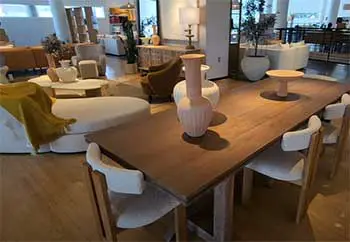
The biggest pro for Crate & Barrel, in my opinion, is their unwavering commitment to quality.
I’ve always been impressed with the craftsmanship and materials used in their products.
Their furniture feels solid and well-constructed, and their kitchenware is designed to last a lifetime.
I see a Crate & Barrel purchase as a long-term investment in my home.
Their timeless designs are another major advantage. Crate & Barrel manages to create pieces that feel modern and relevant without being overly trendy. I’m confident that a Crate & Barrel sofa or dining table will look just as stylish in a decade as it does today.
This makes them a great choice for those who want to invest in furniture that they won’t have to replace in a few years.
I also have to commend them on their exceptional wedding registry experience. They make the process so easy and enjoyable for couples, and their wide range of products, from furniture and decor to kitchen appliances and gadgets, makes them a one-stop-shop for outfitting a new home.
The Potential Downsides of Crate & Barrel
As with the other two brands, the price point at Crate & Barrel can be a significant consideration. They are definitely in the higher-end of the market, and their prices reflect the quality of their materials and construction.
While I believe you get what you pay for at Crate & Barrel, it’s not a budget-friendly option.
While their modern, sophisticated aesthetic is a major draw for me, it might not be everyone’s cup of tea. If you prefer a more rustic, bohemian, or traditional look, you might find their offerings a bit too sleek and contemporary.
Finally, while they offer a good degree of customization for their upholstered furniture, the range of options might not be as extensive as what you’ll find at West Elm or Pottery Barn.
Their aesthetic is more tightly curated, which means you have a bit less freedom to create a truly one-of-a-kind piece.
How They Really Stack Up?
So, after all my Browse, buying, and real-world testing, how do these three giants truly compare? Let’s break it down.
- Style and Aesthetics: This is perhaps the most significant differentiator. If you’re drawn to mid-century modern design with a bohemian or eclectic twist, West Elm is your clear winner. If you crave a classic, comfortable, and timeless home with a touch of farmhouse charm, Pottery Barn will feel like a perfect fit. And if your heart lies with clean, modern lines, sophisticated silhouettes, and a timeless yet contemporary feel, Crate & Barrel will not disappoint.
- Quality and Durability: In my experience, Crate & Barrel and Pottery Barn are neck-and-neck when it comes to quality, with both brands offering well-made, durable furniture that is built to last. I would give a slight edge to Crate & Barrel for the consistent quality across all their product categories, from furniture to kitchenware. Pottery Barn’s solid wood furniture is incredibly robust, but I’ve found their quality to be a bit more variable in smaller decor items. West Elm, while offering many great pieces, can be more of a mixed bag in terms of quality, so it pays to be a more discerning shopper there.
- Price and Value: All three brands are considered mid- to high-end, but there are some nuances. West Elm generally has the most accessible price point of the three, especially for decor and smaller furniture items. Pottery Barn and Crate & Barrel are quite comparable in price, with both being a significant investment. When it comes to value, I believe all three brands offer good value for their respective price points and target audiences. With West Elm, you’re paying for style and trend-forward design. With Pottery Barn and Crate & Barrel, you’re paying for quality, durability, and timeless appeal.
Frequently Asked Questions (FAQ)
In my experience, Crate & Barrel generally has a more consistent and higher level of quality across their product lines compared to West Elm.
Both Crate & Barrel and Pottery Barn offer high-quality furniture, but they excel in different areas. I’ve found Crate & Barrel to be exceptionally consistent in quality, while Pottery Barn’s solid wood furniture is particularly robust and durable.
No, I would generally consider Pottery Barn to be in a higher price tier and perceived as more “high-end” in terms of its classic, investment-piece positioning compared to the more trend-focused West Elm.
No, Crate & Barrel is not owned by Pottery Barn. They are separate companies. Pottery Barn is owned by Williams-Sonoma, Inc., which also owns West Elm. Crate & Barrel is owned by the Otto Group.
Wrapping Up
After walking you through my personal journey and analysis of West Elm, Pottery Barn, and Crate & Barrel, I hope you have a clearer picture of what each brand has to offer.
There’s no single “best” choice—the right one for you depends entirely on your personal style, your budget, and what you value most in a home.
If you are a trend-conscious individual who loves mid-century modern design and wants to create a stylish, contemporary home, I believe you will find a lot to love at West Elm.
If you are seeking to create a warm, inviting, and family-friendly space with timeless, classic furniture that will last for years to come, then I encourage you to explore all that Pottery Barn has to offer.
And if your aesthetic leans towards modern, sophisticated, and timeless design, and you appreciate high-quality craftsmanship and a curated collection of home goods, then I am confident that you will be delighted with the offerings at Crate & Barrel.
Ultimately, the power to create your perfect home lies with you, and now you are better equipped to make that choice.
